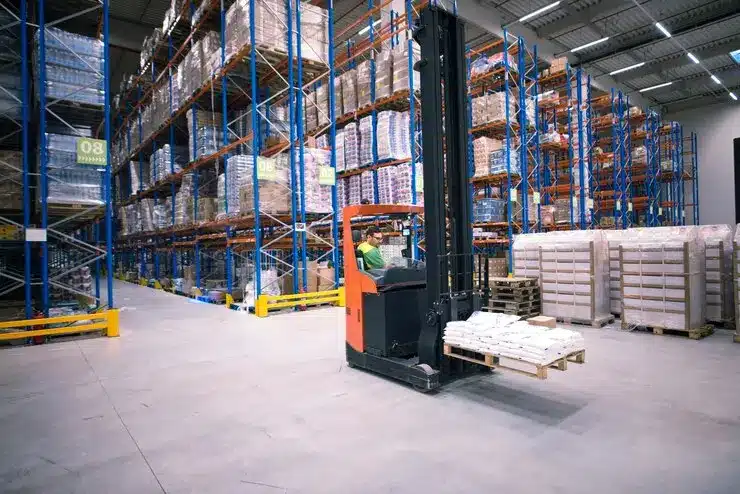Efficient goods storage from IMPORA International
What is goods storage?
Goods storage refers to the process in which goods are brought to a warehouse after their delivery and systematically stored there. This process includes receiving the goods, checking the delivered items, labeling and finally assigning a storage location. Efficient storage of goods is crucial for warehouse management and ensures that goods can be retrieved quickly and accurately at any time.
Assignment of the storage compartment during storage
Assigning the correct storage compartment is an essential part of storing goods. Each storage compartment is systematically assigned according to certain criteria such as size, weight, expiry date and turnover rate of goods. A well-designed storage system minimizes search times and optimizes storage space. Modern warehouse management systems use algorithms to ensure the most efficient placement of goods.
Storage – the key figures
Key figures are crucial for measuring and continuously improving the efficiency of goods storage. The most important metrics include lead time, storage time per unit, storage space utilization and inventory accuracy. These key figures help to identify bottlenecks and optimize processes.
Why does the storage of goods have to be recorded?
Accounting for the storage of goods is essential to ensure accurate inventory management. Every goods received must be recorded in the system and provided with the relevant information such as quantity, supplier and storage date. This enables complete traceability and prevents inventory differences. Proper accounting is also necessary for accounting and legal reasons.
Acceptance and labeling in goods receipt
Goods receipt includes the acceptance of the delivered goods, their inspection and labeling. Acceptance includes checking the delivered quantities and items for compliance with the orders. After acceptance, the goods are labeled so that they can be clearly identified and tracked. These labels contain information such as item numbers, batch numbers and expiry dates that are necessary for inventory management and subsequent retrieval.
What should be taken into account when storing goods?
When storing goods, various factors must be taken into account to ensure efficient and proper storage. These include:
- Storage conditions: Ensuring suitable storage conditions such as temperature, humidity and lighting.
- Safety regulations: Compliance with safety and health regulations, especially when storing dangerous goods.
- Expiry dates: Consideration of expiry dates when placing the goods to FIFO (First In, First Out) or FEFO (First Expired, First Out).
- Accessibility: Ensuring frequently used goods are easily accessible to minimize picking time.
Accelerated storage of goods thanks to barcodes and scanners
What are the principles of proper storage of goods?
Proper storage of goods is based on several principles:
- Care: Careful inspection and handling of the goods to avoid damage.
- Order: Systematic and clear storage of goods to ensure they can be found.
- Documentation: Detailed recording and documentation of all storage-relevant data.
- Security: Compliance with security standards to ensure the integrity of goods and the safety of employees.
- Transparency: Creation of transparency through complete traceability of all goods movements.
Digital goods storage: process and procedure
Digital goods storage uses modern technologies to optimize and automate the storage process. The process includes:
- Acceptance: Digital recording of the delivered goods using a scanner.
- Check: Automated check for completeness and consistency with the order data.
- Labeling: Automatic generation and application of barcodes.
- Storage: Algorithm-supported allocation of an optimal storage space.
- Booking: Automatic booking of goods in the warehouse management system.
Storage systems in comparison
There are various storage systems that can be used depending on the requirements and type of goods:
- Chaotic warehousing: Goods are stored in any free space, with the system documenting the exact storage location.
- Fixed storage location: Each item has a fixed storage location, which makes management easier but less flexible.
- Zone storage: The warehouse is divided into zones, with similar items stored in the same zone.
- Flow racking: Dynamic storage for frequently handled goods, where the older goods are removed first.
Advantages of digital goods storage
Digital goods storage offers numerous advantages:
- Increased efficiency: Automation reduces storage times and minimizes errors.
- Cost savings: Lower personnel costs and more efficient use of storage space.
- Transparency: Real-time data enables complete traceability and better inventory management.
- Flexibility: Quick adaptation to changing requirements and flows of goods.
Conclusion of goods storage
The storage of goods is a central process in warehousing that requires careful planning and efficient processes. By using modern technologies and tailor-made solutions, the efficiency of storing goods can be significantly increased. IMPORA International offers comprehensive services that optimize your warehouse organization and improve your processes. Use our expertise to take your warehousing to the next level.
Further information worth knowing about goods storage
There are many other aspects of goods storage that are relevant for efficient warehousing. This includes the integration of IT solutions, the continuous training of employees and the regular review of warehouse processes. IMPORA International offers you comprehensive advice and support to ensure that your goods storage always functions optimally.
The importance of employee training when storing goods
Employee training is a crucial factor for the efficiency of goods storage. Well-trained staff can carry out processes faster and more accurately. Regular training and education ensure that employees are always up to date with the latest technology and can use the latest procedures and technologies efficiently. This contributes significantly to optimizing inventory and minimizing errors.
Integration of IT solutions into goods storage
FAQs
-
What is goods storage?
Goods storage refers to the process in which goods are brought to a warehouse after their delivery and systematically stored there. This process includes receiving the goods, checking, labeling and assigning a storage location. -
Why is recording the storage of goods important?
Recording the storage of goods is essential for accurate inventory management. It enables complete traceability and prevents inventory differences that can lead to delivery problems. -
Which technologies support goods storage?
Barcodes and scanners are key technologies that improve the efficiency of goods storage. They enable quick and accurate identification and accounting of goods. -
What are the principles of proper storage of goods?
Proper storage of goods is based on the principles of care, order, documentation, security and transparency. -
How can the efficiency of goods storage be increased?
By using modern technologies such as barcodes and scanners, implementing efficient storage systems and continuously reviewing processes, the efficiency of goods storage can be significantly increased. -
What advantages does digital goods storage offer?
Digital goods storage offers advantages such as increased efficiency, cost savings, transparency and flexibility. Automated processes reduce storage times and minimize errors.








